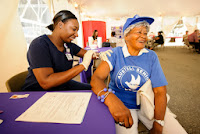This was originally posted on The Mom's Guide to San Diego and was written by Dr. Jaime Friedman.
As a local pediatrician, and part of the medical group that partners with the Mom’s Guide to San Diego, I felt it was very important to respond to a recent thread of posts on the Mom’s Guide Facebook page regarding flu vaccines. The media often highlights extreme medical cases for the sake of the “story”, sometimes without providing thorough information on the topic for the viewer to come to their own educated conclusion.
Every year many thousands of people become ill with influenza. Of those, hundreds to thousands die. Unfortunately, while the very old, very young and chronically ill are most severely affected, many who die of influenza are perfectly healthy. Influenza should not be confused with the common cold or a viral illness causing vomiting and diarrhea. It is more severe, causing sudden onset of high fever, body aches and fatigue. Many people also experience a cough, headache, sore throat, or diarrhea. The illness is very uncomfortable and can result in pneumonia, bronchitis or sinusitis. It also can exacerbate chronic illnesses including asthma. Most people are sick for 1-2 weeks.
The best ways to prevent the flu are good hand washing and vaccination. The vaccine was first introduced in the 1940s for the military. Since then it has repeatedly been perfected and proven to be safe and effective. In fact, each year the vaccine is altered to keep up with the mutating virus. The vaccine works by introducing proteins from the surface of the virus into the body so that the individual can make their own antibodies to the virus. The injected vaccine is NOT a live virus and one cannot get the flu from the vaccine. Because the vaccine is given during respiratory virus season many people develop other illnesses around the same time as vaccination and mistake that illness for “getting the flu from the shot”. Also, it takes 2 weeks for the vaccine to be effective so exposure to the virus around the time of vaccination can still result in illness. Some common side effects include soreness at injection site, feeling achy and low grade fever for 1-2 days. These symptoms are far less severe than actually having an influenza infection. There is also a live attenuated vaccine available that is sprayed into the nose. While this is a live virus it is weakened so that it does not cause infection. However, side effects may be more prominent than injection, including runny nose, headache and wheezing. It should not be given to people with a history of asthma.
While serious reactions, such as allergy or anaphylaxis, are rare they do occur. Do not get the vaccine if you have had a reaction in the past or if you have a severe allergic reaction to eggs. Signs of a severe reaction include hives, paleness, dizziness, difficulty breathing and racing heart rate. The number of severe reactions to the vaccine is far less than the number of severe infections that occur every year.
Here at Children’s Physicians Medical Group we believe that vaccination is safe and the best way to prevent infection. Our doctors offer the vaccine to children 6 months and up. For more information, and to determine which type of flu vaccine is best for your child, please contact your pediatrician or go to the CDC website www.flu.gov.





